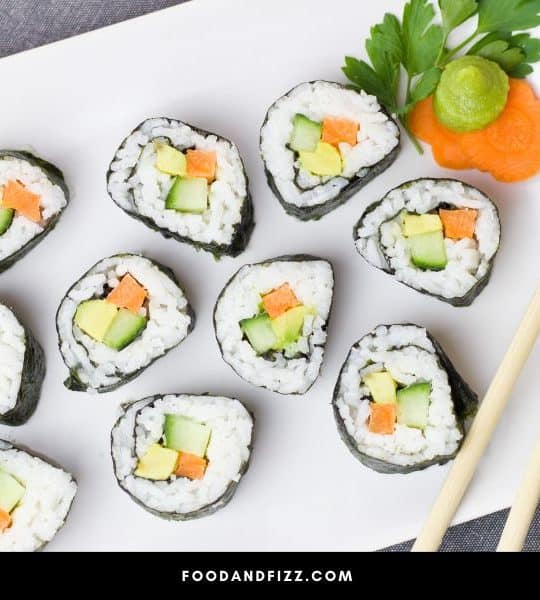You browse a sushi menu and see maki rolls and hand rolls put in different categories, and now you’re confused. You know there must be a difference between the two, but you’re not sure what it is.
Maki roll vs hand rolls- what’s the difference?
Maki Rolls vs Hand Rolls – What’s the Difference?
Maki rolls and Hand Rolls are both types of rolled sushi with a covering of seaweed on the outside. While their contents can be similar, Maki Rolls are rolled with a bamboo mat, are more cylindrical in shape, smaller in size, and come in multiple pieces when served. Hand Rolls are rolled by hand without a bamboo mat, are more conical in shape, comes in much larger sizes, and are usually served as individual servings. Maki rolls are usually eaten using chopsticks, while Hand Rolls, as the name suggests, are meant to be eaten with the hands.
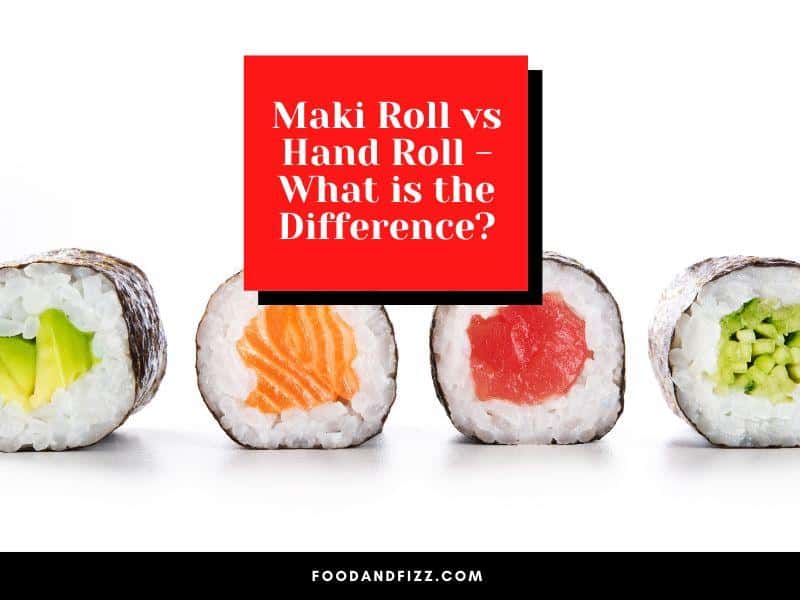
What is Sushi?
Sushi is one of the staple and hallmark dishes of Japanese cuisine.
It usually consists of cooked, vinegared rice, seaweed, and a filling or garnish of a variety of vegetables, eggs, and raw or cooked seafood, although nowadays sometimes meat is also used.
Wasabi, soy sauce, and pickled ginger or gari are usually served with it.
History of Sushi
The earliest reference to sushi can probably be traced back to China somewhere between the 5th and 3rd centuries BC, mainly as a means of preservation for fish. To make it last longer in storage, fish was fermented in rice and salt.
The rice would be wrapped around the fish to preserve it and would be discarded and the fish, consumed. The bacteria produced during the process of fermentation of the rice prolonged the shelf life of the fish.
This is what’s known as narezushi, and many believe that it was the earliest ancestor of sushi as we know it today. Narezushi has been prominent in Asia for centuries, and it is still made in some parts of Japan today.
Evolution of Sushi in Japan
By the early 8th century, the concept of sushi became more prominent in Japan and was mentioned in a document from the year 718 called the Yoro Code.
The exact form of sushi mentioned here is unknown but is likely a variant closer to the narezushi that has been prominent in the region for centuries.
As the years progressed, sushi slowly evolved. By the 17th century, a man named Matsumoto Yoshiichi from Edo (modern-day Tokyo) found that by seasoning the rice with vinegar, the fermentation process can be significantly shortened, and the fish can be consumed within days instead of months.
By the year 1820, a man named Hanaya Yohei wandered around Edo and began working on what was to become the first-ever sushi stall in Japan, in the district of Ryoguku.
Whereas prior to this, the most common form of sushi was “boxed sushi” or hako-zushi, (vinegared rice was packed with fish in a box), Hanaya Yohei changed the form and started molding rice and placing thin strips of fish on top of it (precursor to today’s nigiri sushi). Using fish caught in Edo Bay, edo-maezushi was born.
Hanaya Yohei is generally considered to be the inventor or creator of modern-day sushi, and the first one to make it available commercially. It is this form of sushi, edo-maezushi, that ushered in the sushi that we all know and love today.
Types of Sushi
When we say sushi, we normally only think of nigiri sushi, or perhaps even maki rolls. We normally think of seaweed, rice and filling, but there are actually many different types, with some even not making use of the traditional seaweed: “8 Types of Sushi Without Seaweed“.
But there are actually many different types of sushi, some more common than others. We’ll explore some of them below.
1. Nigiri Sushi
I think this is the default kind of sushi we think about when sushi is mentioned. Slices of raw or cooked seafood are placed on top of molded, seasoned vinegared rice.
A strip of seaweed around it may or may not be present. It is not limited to just seafood as sometimes, strips of Japanese rolled egg omelet, called tamagoyaki, are also formed in this way.
This is actually one of my favorites – Tamago Nigiri Sushi.
2. Makizushi or Maki Rolls
When sushi is wrapped in seaweed or nori, meaning the rice and toppings and fillings are inside, it is called norimaki.
When the seaweed is inside, along with the fillings, and the rice is outside, the rolls are called uramaki which means “inside out roll”.
Maki rolls are normally rolled with a bamboo mat into one long cylinder and cut into smaller pieces. Depending on the place where you get them, the size and number of pieces may vary, but they normally come in multiple pieces and servings.
They can be eaten by hand but are usually eaten with chopsticks.
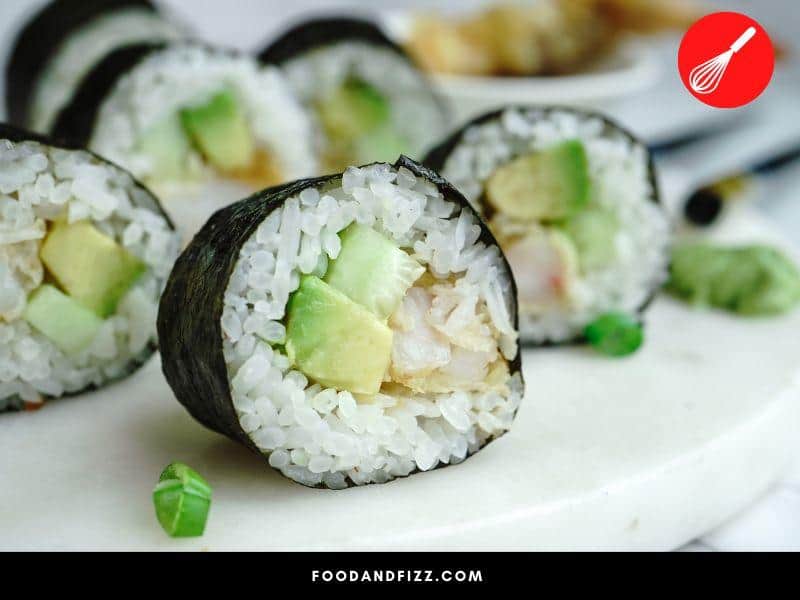
3. Temaki or Hand Rolls
Also known as hand rolls (“te” means hand), Temaki is an ice cream cone-shaped, hand-rolled sushi roll that is larger than a maki roll and is best eaten by hand.
Like maki rolls, they are also rolled with nori or seaweed on the outside and fillings on the inside but unlike maki rolls which are normally cut into several small pieces and would make for multiple servings, Temaki is usually one larger piece and consists of just one individual serving.
You may get several pieces per order at some places though, but in general, it is geared for individual servings.
While maki rolls are rolled using a mat, temaki is usually done without the use of a mat, hence their conical shape.

4. Sashimi
Sashimi is also one of the more well-known types of sushi. It consists of rectangular-shaped slices of raw seafood, like salmon, tuna, mackerel, shrimp and others, and is served without the seasoned rice.
5. Hakozushi or Boxed Sushi
This type of sushi is the precursor of nigiri sushi. Rice and fillings are packed into attractive shapes and patterns and compressed in beautiful presentation boxes.
It is popular in Osaka but because it is quite a labor-intensive endeavor to make (to maintain consistent quality of design, etc), it is not as often seen nowadays.
6. Chirashizushi
The word chirashi means “scattered”, and so this type of sushi consists of a bowl of vinegared and seasoned rice with slices of raw seafood or sashimi scattered over it, along with other various toppings. It essentially is like a sashimi bowl.
So there you have it, some of the more common and interesting types of sushi. It is by no means an exhaustive list as sushi has lots of different variations and sub-variations, depending also on the region they are from, but the types we outlined above are a good start for sushi novices.
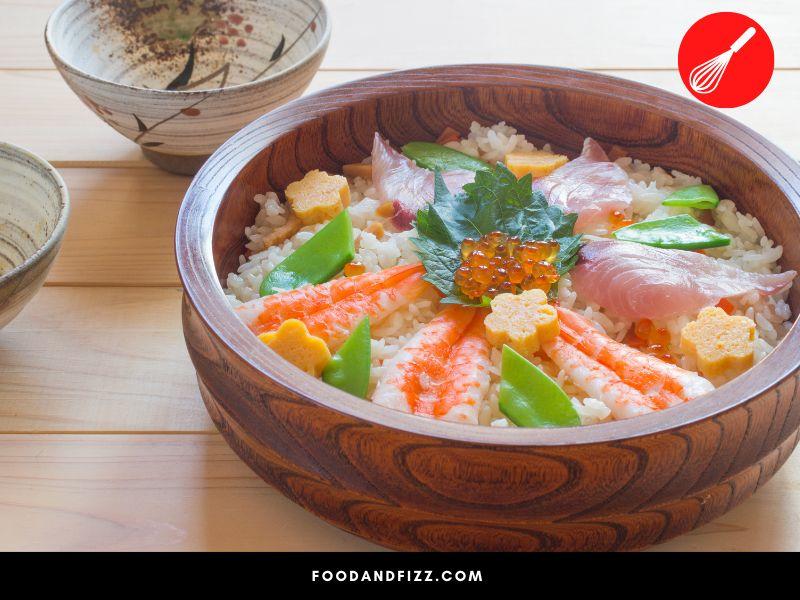
Maki Roll vs Hand Rolls – What’s The Difference
As we have seen from the different types of sushi, maki rolls and hand rolls share a common trait: they are both a type of cylindrical, rolled sushi with seaweed or nori on the outside, and fillings on the inside (although uramaki, or the “inside out sushi”, rebels against this characteristic).
They differ in four main ways:
1. Size and Shape
Maki rolls are normally smaller in size compared to hand rolls. While you can definitely find bigger maki rolls, they probably won’t be as big as hand rolls, or temaki.
Maki rolls are also typically more cylindrical and rounder in shape, while hand rolls are conical in shape, like an ice cream cone.
2. Serving Size or Number of Pieces
Maki rolls are normally served in multiple servings. Depending on the place where you get it from, the number of pieces can range from 6-8 to 12. Hand rolls are usually just individual pieces or servings.
3. Way of Rolling
Maki rolls are rolled using a bamboo mat, which makes their cylindrical shape more uniform across all pieces. Hand rolls are hand-rolled without the use of a mat, which is why they can be shaped into a cone.
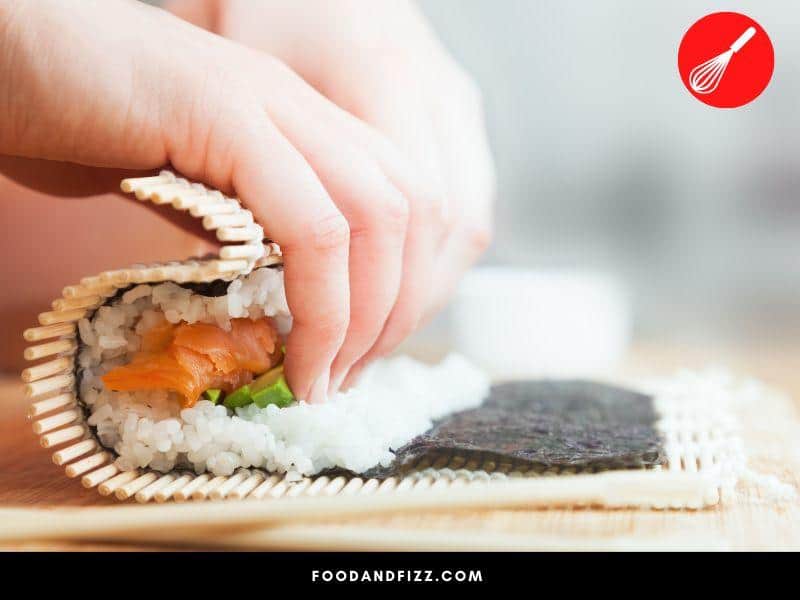
4. Way of Eating
If you wish, you can eat most types of sushi by hand, and that includes maki rolls. However, they are often eaten using chopsticks.
Hand rolls, on the other hand, because of their unique shape, are best eaten with your hands.
Is Sushi Healthy?
Depending on the type of sushi and way of preparation, sushi can be a part of a healthy diet. Seafood like salmon and tuna contain lots of health benefits like omega-3 fatty acids, vitamins, and minerals, which are definitely beneficial to the body.
They are also a good, lighter source of protein compared to heavier meats. As with anything though, proper portion control is advised. And if you have sensitivities to seafood, especially raw seafood, or soy sauce, which is typically served with sushi, it will be good to proceed with caution.
Also, since most types of sushi are raw, it is important to only get sushi only from reputable sources and restaurants that practice safe handling and storage procedures to avoid the incidence of a potentially serious food-borne illness.
Conclusion to Maki Rolls Vs Hand Rolls
Maki rolls and Hand rolls may consist of the same ingredients and fillings and may even look similar in some cases, but they are different in the way they are prepared, shaped, and served.
Aside from these two kinds, there are dozens of other types of sushi that are waiting to be explored in your sushi journey.
Frequently Asked Questions to Maki Rolls Vs Hand Rolls
What is the Difference Between Sushi and Sashimi?
Sushi is vinegared and seasoned rice topped or filled with slices of raw or cooked seafood and a variety of other toppings. Sashimi, on the other hand, is thin, rectangular slices of raw seafood which are served without the vinegared and seasoned rice.
What Is Temaki?
Temaki is what’s known as hand roll sushi, or a type of sushi that is shaped like an ice cream cone. Vinegared rice, along with various fillings and toppings is wrapped in nori or seaweed without the use of the traditional bamboo mat. The servings for temaki are usually individual and they are best eaten by hand.

